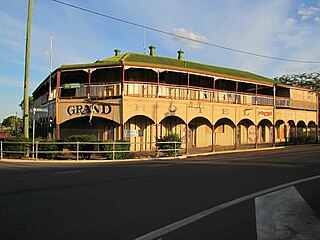
Regatta Hotel is a heritage-listed hotel at 543 Coronation Drive on the corner of Sylvan Road, Toowong, City of Brisbane, Queensland, Australia. It faces the Toowong Reach of the Brisbane River and was named after the rowing regattas held there. It was designed by Richard Gailey and built in 1886 by George Gazzard. It was added to the Queensland Heritage Register on 21 October 1992.

Customs House Hotel is a heritage-listed hotel at 116 Wharf Street, Maryborough, Fraser Coast Region, Queensland, Australia. It was built in 1868. It was added to the Queensland Heritage Register on 21 October 1992.

Lockyer Hotel is a heritage-listed hotel at Victoria Street, Forest Hill, Lockyer Valley Region, Queensland, Australia. It was built from 1906 to 1970s. It was added to the Queensland Heritage Register on 21 October 1992.

Marburg Hotel is a heritage-listed hotel at Edmond Street, Marburg, City of Ipswich, Queensland, Australia. It was built from c. 1881 to c. 1890. It was added to the Queensland Heritage Register on 21 October 1992.

Central Hotel is a heritage-listed hotel at 140 High Street, Stanthorpe, Southern Downs Region, Queensland, Australia. It was built from 1908 to c. 1978. It is also known as Quinn's Hotel and Sheahan's Hotel. It was added to the Queensland Heritage Register on 21 October 1992.

The Criterion Hotel is a heritage-listed hotel at 84 Palmerin Street in Warwick, Queensland, Australia. It was designed by Dornbusch & Connolly and built in 1917 by Connolly & Bell. It was added to the Queensland Heritage Register on 21 October 1992.

Railway Hotel is a heritage-listed hotel at 1 Station Road, Gympie, Gympie Region, Queensland, Australia. It was designed by Alexander Brown Wilson and built in 1915 by J J Georges. It was added to the Queensland Heritage Register on 12 June 2008.

Engineers' Arms Hotel is a heritage-listed former hotel at 115 March Street, Maryborough, Fraser Coast Region, Queensland, Australia. It was designed by Samuel Bragg and built in 1889 by Mr Caldwell. It is also known as Mayfair Boarding House. It was added to the Queensland Heritage Register on 21 October 1992.
Post Office Hotel is a heritage-listed hotel at Bazaar Street, Maryborough, Fraser Coast Region, Queensland, Australia. It was designed by Victor Emmanuel Carandini and built in 1889 by Mr Murray. It was added to the Queensland Heritage Register on 21 October 1992.

Hotel Francis is a heritage-listed former hotel at 310 Kent Street, Maryborough, Fraser Coast Region, Queensland, Australia. It was built in 1878. It is also known as Metropolitan Hotel (1878-1935). It was added to the Queensland Heritage Register on 21 October 1992.

Hotel Childers is a heritage-listed hotel at 59 Churchill Street, Childers, Bundaberg Region, Queensland, Australia. It was built from c. 1895 to 1930s. It is also known as Queen's Hotel. It was added to the Queensland Heritage Register on 21 October 1992.

Federal Hotel is a heritage-listed hotel at 71 Churchill Street, Childers, Bundaberg Region, Queensland, Australia. It was built c. 1907. It was added to the Queensland Heritage Register on 21 October 1992.

Grand Hotel is a heritage-listed hotel at 106-110 Churchill Street, Childers, Bundaberg Region, Queensland, Australia. It was designed by Anton Hettrich built from 1899 to 1900. It is also known as Childers Hotel. It was added to the Queensland Heritage Register on 21 October 1992.

Queensland National Hotel is a heritage-listed former hotel at 28 Morgan Street, Mount Morgan, Rockhampton Region, Queensland, Australia. It was designed by John William Wilson and built in 1890. It is also known as Wesleyan Mission Hall. It was added to the Queensland Heritage Register on 21 October 1992.

Babinda Air Raid Shelter is a heritage-listed former air raid shelter and now public toilets at 109 Munro Street, Babinda, Cairns Region, Queensland, Australia. It was designed by Department of Public Works (Queensland) and built in 1942 by Mulgrave Shire Council. It is also known as Babinda Public Toilet Block. It was added to the Queensland Heritage Register on 16 April 2010.

Floriana is a heritage-listed former private home and now guesthouse at 183-185 The Esplanade, Cairns North, Cairns, Cairns Region, Queensland, Australia. It was designed by Edwin Roy Orchard and built in 1939. It was added to the Queensland Heritage Register on 30 April 2010.

Central Hotel is a heritage-listed former hotel and now shopping centre at 39 - 49 Lake Street, Cairns City, Cairns, Cairns Region, Queensland, Australia. It was designed by Tunbridge, Tunbridge & Lynch and built from 1908 to 1909 by W Phillips. It is also known as Central Building and Central Court. It was added to the Queensland Heritage Register on 21 October 1992.

Exchange Hotel is a heritage-listed hotel at 2 Front Street, Mossman, Shire of Douglas, Queensland, Australia. It was designed by Vibert McKirdy Brown and built from 1934 to 1935. It was also known as Daintree Inn. It was added to the Queensland Heritage Register on 9 November 2012.

The Grand Hotel was a heritage-listed hotel at 36 Stansfield Street, Hughenden, Shire of Flinders, Queensland, Australia. It was designed by Munro and Co and built in 1910 by Richie and Doig. It was added to the Queensland Heritage Register on 27 April 2007. It was destroyed in a fire on 16 November 2018.

Hotel Corones is a heritage-listed hotel at 33 Wills Street, Charleville, Shire of Murweh, Queensland, Australia. It was designed by William Hodgen junior and built from 1924 to 1929 by day labour. It is also known as Corones Hotel Norman. It was added to the Queensland Heritage Register on 1 July 1997.























